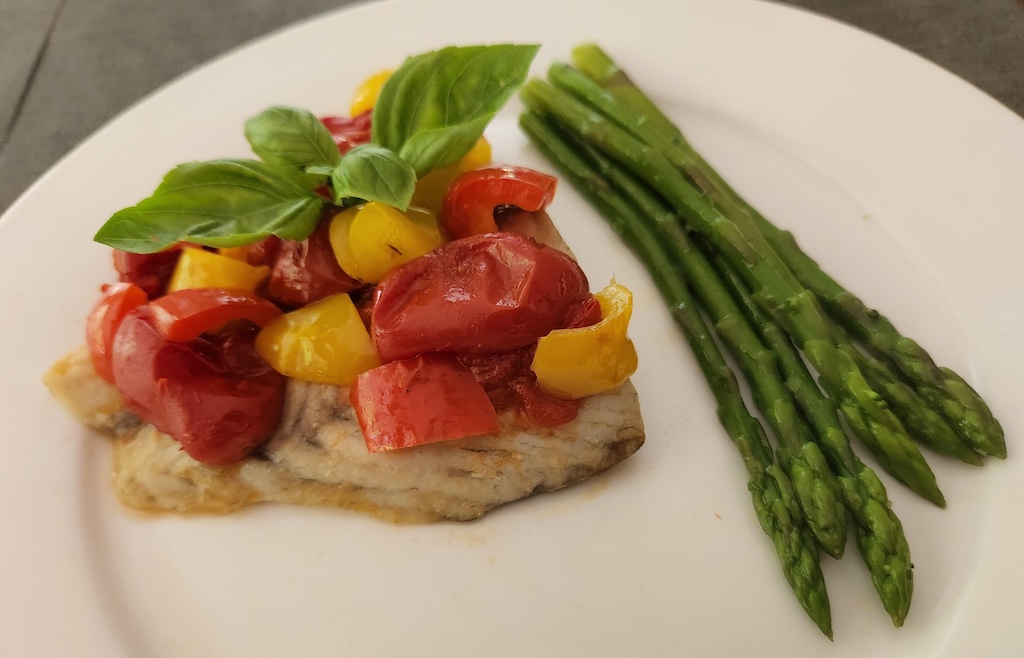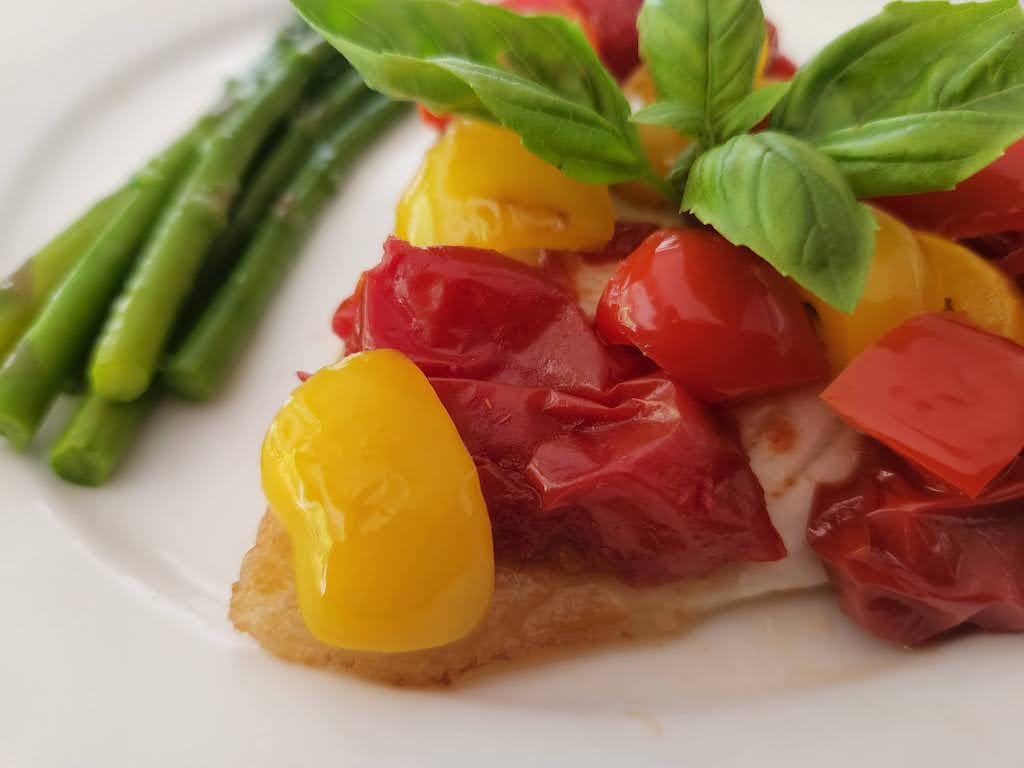This broiled sea bass with corbarino tomatoes recipe could not be simpler or quicker, yet the result is an amazingly delicious and complex dish. The secret, as usual, is using great ingredients and letting them shine. The stars of this dish are sea bass and corbarino tomatoes, and we’ll walk you through how to get the most out of them.
Traditionally, cooks in Italy use fish as a base item and compliment the fish with the creative use of locally available vegetables, herbs, stock, and sauces to add additional flavors to the fish. Along with the tomatoes, you can use your imagination to add additional toppings. I kept this dish simple, adding only the tomatoes, fresh sage, the juice from the canned tomatoes, and a little bit of red and yellow peppers that have been lightly seared. Let your tastes guide you regarding herbs and additional toppings.
I also made an even simpler version of this recipe, where I prepared one fillet only with the tomatoes that had been cooked with rosemary and a second fillet that added black olives to the rosemary-infused tomatoes. Next time I might be more adventurous and add some Italian goat cheese like Caprino to the finished dish. Ultimately, I found the version with the peppers to be the best fusion with the sea bass!
Sea Bass
Preparing Sea Bass
You can prepare the fish however you prefer. I really like broiled sea bass, and do so using a simple toaster oven. You could broil in a full oven, bake, or saute in a pan. It really doesn’t matter as long as you don’t overcook the fish! Aim for 145°F (63°C) with a meat thermometer if you’re not confident in nailing the temp.
Fresh and just-caught, as always, is best. But if that’s not available, you can absolutely use frozen filets with very little diminishment of flavor and texture. Just make sure they’re fully thawed before cooking!

Which sea bass is best?
To begin with, let’s get clear on what we mean by “sea bass”. As with everything in cooking there are many varieties, including several that aren’t technically bass at all. For example, a current favorite on restaurant menus in the US is “Chilean sea bass” which is actually the “Patagonian Toothfish” – a hideous creature that happens to taste great but needed a PR makeover.
Italy, unsurprisingly, has the European sea bass as the local species. It goes by many names in different countries, including four different names in Italy. Most popularly, “Branzino” in the northern part of the country, but also: “Spigola” in the peninsula, “Ragno” in Tuscany, and “pesce lupo” elsewhere. Outside of Italy, almost every country has its own name for the same species. Let’s call it “Branzino” – for no other reason than I think it sounds the coolest.
In the US, there are a handful of varieties that are common: the aforementioned Chilean Sea Bass (which is more like cod), the Striped Bass, the Black Sea Bass, the Giant Black Sea Bass (actually wreckfish, not a sea bass), and the white sea bass (a croaker, not actually a sea bass). They’re all delicious, and all would be great to use in this dish – except one. The Giant Black Sea Bass is actually protected because it is endangered, as its habitat (giant kelp forests) are rapidly disappearing along the North American Pacific coast.
Sea Bass Substitutes
You can use any of the available varieties of sea bass in this dish. It’s all but guaranteed you’ll have at least one of them available at your local grocery store or fishmonger.
Other than sea bass, you this dish would do well with any white or light-colored flaky fish. Halibut, grouper, or cod would all be great choices.
Corbarino Tomatoes
All we’re aiming to do when cooking the tomatoes is to break them down a little bit to get the texture and temperature right. If you’ve found Corbarino tomatoes (or some of the ideal substitutes) they are so flavorful to begin with they don’t really need any help.
I *highly* recommend tracking down canned/jarred Carborino tomatoes. They’re so delicious with a deep flavor that blends superbly with the broiled sea bass. They originate along the coast south of Naples, and the salinity of the sea air seems to make them destined to accompany fish dishes.
We wrote a detailed post all about Corbarino tomatoes, check it out to learn more.
Corbarino Substitutes
There are a few really ideal replacements for Corbarinos in this recipe, and a few adequate replacements that should be super easy to find:
- Datterini – are a mini-plum variety that are also super sweet.
- Piennolo del Vesuvio – are grown in the same region and are also small and sweet, but have a slightly bitter finish to the taste.
- Cherry or Grappolo Pachino – the smaller varieties of the Pachino tomatoes are delicious and not dissimilar in flavor profile to the Corbarino. These grow on the coast in Sicily, and similarly benefit from the salinity of the water and air.
- Cherry or Grape – whatever small tomatoes are available at your local grocery store or farmer’s market will work just fine, especially if they’re in season
Recipe Card
Broiled Sea Bass with Corbarino Tomatoes

Directions
- Step 1 Add olive oil and garlic cloves to a skillet over medium-high heat. Roughly chop red and yellow pepper and add to pan, cooking for a few minutes until your desired softness. Set aside in bowl.
- Step 2 Reduce heat to medium low. Add more olive oil and corbarino tomatoes in the skillet along with about half of the juice from the can. Add a few leaves of fresh sage. Cook for approximated 10 minutes.
- Step 3 Take thawed sea bass fillets and pat dry with paper towel. Coat each side with olive oil, place in baking pan, lightly salt, add a couple of pats of butter to each fillet, and broil for 6- to 7-minutes in a toaster oven.
- Step 4 The sea bass should be done just about at the same time as the tomatoes. Plate the fish and add the tomatoes and peppers as topping. Serve while hot along with a vegetable to your liking. That’s it, quick and easy!




